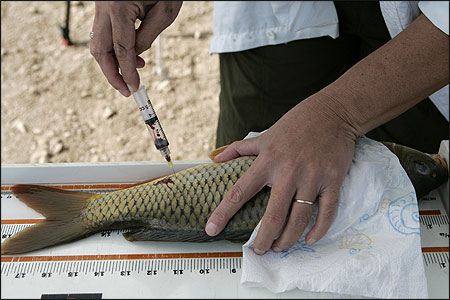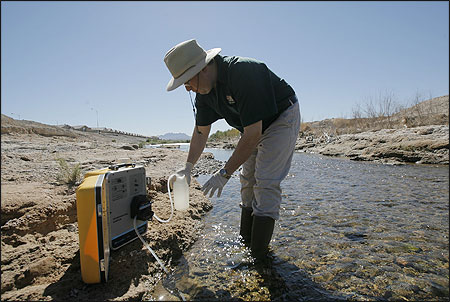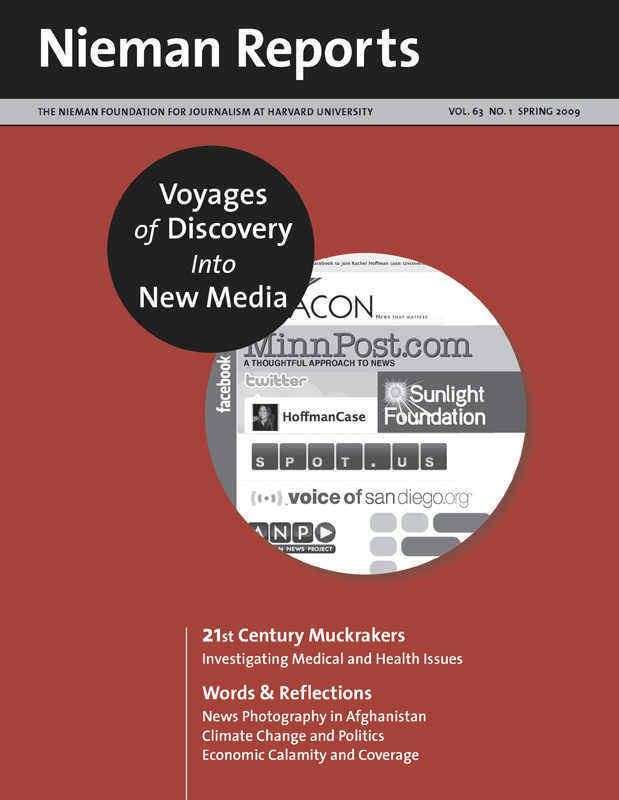
A September 2009 Associated Press report found that toxins in drinking water remain a major issue, especially in schools across the country. Read the story here.
RELATED ARTICLE
"A Water Trail of Antibiotics in India"An investigative reporting project sometimes begins with a whispered tip from an informed insider or a stack of leaked documents from someone with an ax to grind. Frequent topics include corruption, faulty regulations, laws that aren’t enforced properly, or the failure to protect the rights of the downtrodden. How about one where the key is sitting in plain sight, even if it is invisible to the human eye, waiting to be discovered—a subject like pharmaceuticals in our drinking water?
The genesis of The Associated Press (AP) project, “PharmaWater,” can be traced to reporting our national writer Martha Mendoza did in 2005 about dangers associated with birth control patches. She’d noticed that in Europe special disposal packets are required to prevent estrogen from seeping into the environment. When Mendoza mentioned this to one of her journalist friends, she was informed about several studies involving traces of pharmaceuticals being detected in water. A while later this friend, who wrote for a small community newspaper, retired and urged Mendoza to keep looking into this troubling topic.
In the fall of 2007, I rejoined the AP in the newly created position of national investigative editor. Against a landscape of tighter budgets and shrinking investigative-enterprise units at newspapers and other media outlets, AP executives had formulated a plan to expand the news agency’s investigative reporting effort throughout the United States. The challenges and opportunities sounded terrific, especially to a guy who’d spent 13 satisfying years working for this wire service in the 1970’s and 1980’s. Five senior reporters—including Mendoza, who’d won a Pulitzer Prize, been a Knight Science Journalism Fellow, and was a longtime investigative reporter—were assigned full time to form the AP National Investigative Team; they’d work solo, in tandem, and with other AP staffers.
I asked each team member for a list of project possibilities. Among her many ideas, Mendoza proposed an in-depth examination of trace concentrations of pharmaceuticals in our waterways. She’d already come across more than a dozen articles in scientific journals—mostly obscure ones and most of them from Europe—which documented the adverse effects that pharmaceutical drugs in water were having on fish and other wildlife.
Her idea caught my attention. As a reporter or editor, I’d covered toxic dumps, polluted waters, dioxin contamination, Three Mile Island, environmental dangers at Ground Zero, and unprotected chemical plants as open targets for terrorists. Mendoza let me know that scientists were calling pharmaceuticals in water “a potential sleeping giant” and, before long, our team had embarked on a long, exciting journey that would culminate with our issuing a wake-up call to America.
Gathering Information
The PharmaWater team consisted of three reporters. Mendoza was joined by Los Angeles-based Justin Pritchard, who’d won a George Polk Award for a series detailing disproportionate on-the-job death rates in the United States among Mexican-born workers, and Boston-based Jeff Donn, who possesses a doctorate in French literature from Princeton and a deep background in science and medical stories.
Newsgathering was partitioned: Mendoza would concentrate on individual scientists and ongoing research projects, Pritchard’s focus would be on treatment technologies, and Donn would delve into the science community. Each read the literature and called around to learn about testing and test results. To keep us on track—coordinate our efforts and assess the worthiness of this project—we had weekly conference calls lasting upwards of three hours. We shared written updates and used a wiki for, among other purposes, the posting of summaries of every known study. We created databases and spreadsheets.
In all, during the months leading up to publication of our first three-part series in March 2008, the team reviewed hundreds of scientific reports, analyzed many federal drinking water databases, visited numerous environmental study sites and treatment plants, and interviewed more than 230 officials, academics and scientists. To do this, Donn went to New York and Philadelphia—two cities with major pharmaceutical discoveries in their watersheds; Pritchard journeyed to a treatment plant in Fountain Valley, California, where reverse osmosis is used to remove a wide range of pollutants, including pharmaceuticals, but at a heavy financial cost. And Mendoza traveled to Lake Mead in Nevada to watch as scientists stunned seven-pound common carps, scooped them up, and deposited them into 50-quart Coleman ice chests for transport to shore and then to aquatic toxicologists in laboratories across the country.
To be sure, some of the latest environmental research about source water was being discussed publicly—if not widely—in specialized forums. For example, Mendoza and Pritchard attended the 6th International Conference on Pharmaceuticals and Endocrine Disrupting Chemicals in Water, in Costa Mesa, California. Even with such discussions going on among scientists, obtaining actual test results proved to be quite difficult. And no one was talking openly about pharmaceuticals in drinking water.
We had hoped that agencies like the U.S. Environmental Protection Agency (EPA) and U.S. Geological Survey or industry associations of water purveyors had comprehensive test results for all major U.S. cities that we could use. No such luck. The data didn’t exist or were being kept under wraps.
Pushing Past Secrecy and Fear
Secrecy, it turned out, was our biggest enemy, but not for the reasons investigative reporters typically encounter—well, except for post-9/11 terrorism concerns. I’d always believed that we’d have tough issues to deal with as we got ready to write and publish. We all knew, and discussed many times at length, how critical it would be to balance the importance of our findings against the need not to scare the bejesus out of everyone. In our presentation of the facts, we’d make every effort to be evenhanded and nonalarmist. What none of us expected, however, was the level of resistance we encountered in the reporting process.
We learned that the American Water Works Association Research Foundation (it has since changed its name to the Water Research Foundation) had been involved with testing across the country, but the foundation’s executive director declined to name the 20 different drinking water treatment plants where pharmaceuticals had been detected in water that was eventually used by more than 10 million people. He said the foundation had assured secrecy to participants of its study. Citing confidentiality agreements, he added, “It’s a hard topic to talk about without creating fear in the general public.” We’d hear that refrain often during the ensuing months.
We decided to collect data ourselves and began by surveying the nation’s 50 largest cities, along with the nation’s largest water providers, which added another dozen major utilities to our list. We also called on at least one smaller community water provider in each of the 50 states. Even though the AP has reporters in every state to whom such calls could have been assigned, the three PharmaWater reporters divvied them up along with the e-mails. We wanted to be absolutely certain that our questions, and the answers, were apples and apples.
Some of our initial interviews left us unable to confirm even that the water in specific cities had been tested. From there, deeper reporting problems emerged: As with industry association folks, several local water utilities and city governments acknowledged they had tested the water but would not reveal results. In some places, officials wouldn’t speak to us at all. Repeated calls were met with repeated brushbacks. For example, New York City water officials declined repeated requests for an interview and waited more than three months before participating in the AP survey, supplying information only after being informed that every other major city in the nation had cooperated. We shamed them into talking to us.
Even before New York City officials reluctantly spoke with us, Donn had discovered that the New York state health department and the U.S. Geological Survey had detected heart medicine, infection fighters, estrogen, anticonvulsants, a mood stabilizer, and the active ingredient in an antianxiety medication in the city’s watershed upstate. Ultimately, the city’s Department of Environmental Protection informed us that it does not test its downstate drinking water.
In Emporia, Kansas, Ron Rhodes, the city’s water treatment plant supervisor, explained why he wouldn’t disclose whether his community’s source water or drinking water had been tested for pharmaceuticals. “Well, it’s because of 9/11,” he said. “We want everybody to guess.” When we asked how it would endanger anyone if the public knew whether Emporia’s water has been screened for minute concentrations of pharmaceutical compounds, he replied, “We’re not putting out more information than we have to put out. How about that?”
In conversations with other water officials, we heard much the same. Philadelphia officials balked at first, then relented, but not before a city water department official declared: “It would be irresponsible to communicate to the public about this issue, as doing so would only generate questions that scientific research has not yet answered. We don’t want to create the perception where people would be alarmed.”
Security-conscious officials in Arlington, Texas, gave us information in drips and drabs. First, they said they’d detected drugs in the city’s source waters but wouldn’t say which ones, or in what amounts, or whether any such drugs had survived the treatment process. Next, the mayor told us a trace amount of one pharmaceutical had survived the treatment process and had been detected in drinking water. He declined to name the drug, saying identifying it could prompt a terrorist to intentionally release more of it, causing significant harm to residents.
Three months later, after we’d filed public records requests—and after assurances from the Texas Attorney General that the terrorism concerns were not well founded—the secret was revealed: Drinking water in Arlington had tested positive for the antianxiety medication meprobamate. The public announcement was made in June 2008; the water samples had been taken in October 2006.

What Reporting Revealed
One year after publication of the first set of PharmaWater stories—which checked in at about 17,000 words—it is rare to find anyone who hasn’t at least heard something about this story. Most people now know the nation’s drinking water supplies are contaminated with minute concentrations of pharmaceuticals, most often excreted down sewers as the unused portion of the medicines we take with increasing regularity. And while science has not yet been able to determine the extent of any possible long-term dangers, the AP findings are sobering:
- At least 46 million Americans consume water contaminated with prescription and over-the-counter drugs. That number is no doubt a gross undercount—most cities and water suppliers do not test. (Our first series, published in March 2008, had tallied 41 million; a follow-up survey six months later added five million.) This year we are working on comparing the communities now contained in our results with a new research project that will probably document an additional 10 million or so.
- In the wild, scientists have found reason to blame pharmaceuticals in the water for severe reproductive problems in many types of fish—razorback suckers and male fathead minnows with lower sperm counts, male carp now called feminized fish, and female fish developing male genital organs. There are problems with other wildlife: kidney failure in vultures, impaired reproduction in mussels, and inhibited growth in algae.
- In the laboratory, there are growing indications that small amounts of medication have affected human embryonic kidney cells, human blood cells, and human breast cancer cells. The cancer cells proliferated too quickly, the kidney cells grew too slowly, and the blood cells showed biological activity associated with inflammation.
- Our follow-up series, in September 2008, revealed that hospitals and long-term care facilities annually dump an estimated 250 million pounds of unused or outdated pharmaceuticals and contaminated packaging. Again, we had to gather this data and do the calculations; up to half of that total could be the drugs themselves.
Publication of our initial stories—with graphics, charts, rollover maps, scores of photos, video and interactive multimedia showing how drugs travel from human ingestion to the kitchen sink—prompted reaction we could not have anticipated. What we’d discovered became front-page news worldwide, on all media platforms, and especially on the Web. Our reporters did TV and radio interviews. A full-length piece appeared in JAMA, the Journal of the American Medical Association. The president of the Society of Toxicology wrote, “The public has a legitimate right to know and the AP story … will lead us more quickly to the answers we need to have.”
Within hours of our project hitting the wire, the first of what would be several congressional hearings on pharmaceuticals in water was announced by the U.S. Senate Committee on Environment & Public Works. When Senator Barbara Boxer opened the session, she drew attention to the prior secrecy and lack of oversight with a stinging admonishment of the EPA’s top water expert: “The Associated Press did your work—and they’re telling us what’s in the water.”
The attention our reporting received—combined with praise we’ve heard for the stories’ fairness and accuracy—has been gratifying. But we’ve just begun—with PharmaWater and other national investigative efforts. At this writing, we are pursuing research about how much U.S.-based pharmaceutical manufacturers contribute to the drug inventory in the environment. President Obama has called for more study and focus on this issue, and the scientific community shows signs of increased concern about the possible links between drugs in our water supplies and emerging medical problems such as increases in the incidence of early puberty and antibiotic resistance. We have little doubt that the PharmaWater story will be with us at the AP for many years to come; regrettably, our reporting tells us these issues will be front and center with most Americans, too, for many decades.
Richard T. Pienciak is the national investigative editor at The Associated Press. He is an author and former assistant managing editor at The (N.Y.) Daily News.
